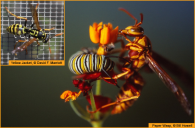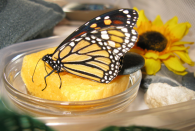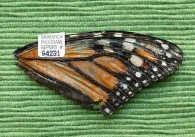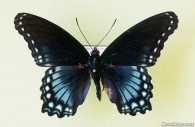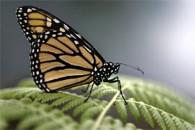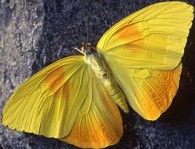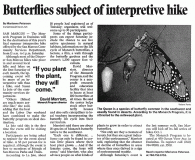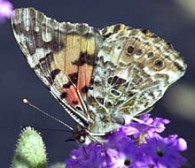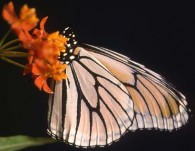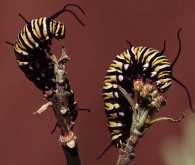Click Here for 2016 Thanksgiving monarch population counts (available February)
Santa Cruz Crows Seen Hunting Monarchs (Watch the Video!)
Corvids Hunting Monarch Butterflies for Sport While working in Santa Cruz, Mike Murphy witnessed a strange phenomenon. He noticed a large band of crows hanging around the trees near where hundreds of monarch butterflies have been overwintering since October 2015. When he first saw them chasing and hunting the monarchs, he knew right away that […]
2015 Thanksgiving Count Data Available
Preliminary data for the 2015 Western Monarch Thanksgiving Counts are available from the Western Monarch Resource Center http://www.westernmonarchcount.org/data/. Count information and population graphs since 1997 are also included.
Butterfly center re-emerges in Bonsall
Butterfly center re-emerges in Bonsall The Monarch Program has been searching for a new home since June 2013 By Pam KragenThe San Diego Union-Tribun BONSALL — It’s been nearly two years since the Monarch Program closed its butterfly education center in Encinitas with the promise of a speedy return in a new and bigger location. […]
Temporary Flight House Open to the Public
Temporary Flight House Open to the Public The public is invited to visit our butterfly house in Pala Mesa, North San Diego County. People of all ages can hand feed butterflies fruit, see caterpillars and the life cycle, take photographs and learn about native butterflies. It is smaller than the previous Encinitas facility (400 sq. […]
Western Monarch Butterfly Thanksgiving Counts 2014
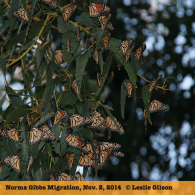
Current Listings of Population and Data for Southern California
(Note: Extremely dry and hot Santa Ana Winds on Nov. 16 & 17 in Los Angeles & Ventura Counties, and Nov. 24 in San Diego County,influenced many butterflies to take flight, move or hide in low dark areas — causing a less accurate count. Information not yet received is represented by the symbol “-”).
Tips for Harvesting Milkweed Seeds: Pluck ‘em, Shake ‘em or Flame ‘em
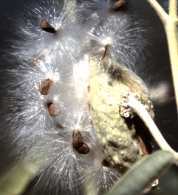
Separating milkweed seeds from the floss can be a messy and aggravating task. I have listed three of the easiest methods I have encountered during the past twenty-five years of growing milkweed plants. The methods shown below are for Aslepias curassavica, however any milkweeds species may be chosen. All techniques for removing seeds from the floss should be done outdoors.
The 2013 Thanksgiving Monarch Counts Begin!
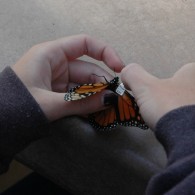
The 2013 Thanksgiving Monarch Counts Begin! This seasons’ Thanksgiving Counts will be held from November 16th through December 8th 2013. The project has been a favorite holiday activity since the counts began in 1997. The goal this season is to have every county checked with as many sites as possible recorded. Click on Thanksgiving Counts […]
2012 Thanksgiving Counts
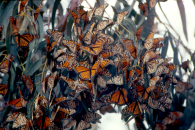
2012 Thanksgiving Counts Monarch Program Volunteer Counters: Kris Ethington, Donna Grubusic, David Marriott, Cynthia Martinson, Mark Walker, and Irene Zabelin. Thirty-three sites were checked from Santa Barbara to San Diego Counties. San Diego County Site Sky Temp. Hum. Population Time Date Hosp Grove, Carlsbad S 65 44% 35 1:45 21 Nov. Camino Real & Chestnut, […]
The Monarch Program Facility in Encinitas is Now Closed

The Monarch Program Facility in Encinitas is Now Closed The facility has been a favorite destination for children on field trips for 21 years. Thousands of families have visited to enjoy the ambiance and intimate environment of the butterfly house and be educated about native butterflies, especially monarchs. There have been young volunteers through the […]
Butterfly farm to spread its wings
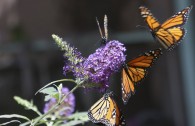
Butterfly farm to spread its wings Encinitas vivarium will close June 23 and relocate to a new, bigger location this summer Written by Pam Kragen JUNE 18, 2013Excerpt from utsandiego.com The Monarch Program and Hatchery currently located in Encinitas will be relocating to a more accessible location that will allow for more sun for the […]
The Monarch Program facility in Encinitas will be closing on June 23rd 2013
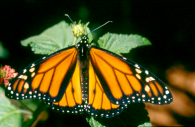
NEWS RELEASE: The Monarch Program facility in Encinitas will be closing on June 23rd 2013. The facility has been a favorite destination for children on field trips for 21 years. Thousands of families have visited to enjoy the ambiance and intimate environment of the butterfly house and be educated about native butterflies, especially monarchs. There […]
Monarch from Washington State Found in Marin County, California, October 2012
Incarcerated Citizen Scientists in Washington at Walla Walla State Penitentiary reared, tagged, and released 2381 monarchs in September. It is a new program designed by Dr. David D. James from Washington State University. Most of the rearing is conducted by a small group of dedicated inmates, whose devotion to the task and project has resulted in exceedingly low mortality rates.
Arizona Monarchs Found in California and Mexico 2009 – 2011
Some butterfly researchers have long believed that there are monarchs that fly from Arizona to spend the winter along the coast of California. This theory was based on overwintering tagged monarch recaptured in Arizona during their spring migration since the 1980’s. Also, experiments with early overwintering monarchs removed from the coast and released in Arizona showed that some traveled back to the coast. But there was no scientific proof that a native Arizona monarch would fly to California or Mexico to spend the winter until 2009.
Mystery Monarch
Monarch Program associate Donna Grubussic reared a monarch butterfly from an egg and released it as an adult on the 30th of September, 2007 from Carpinteria, California. It was a female with tag #64231 placed over the right forewing. On the 4th of January 2008 the entire forewing of the butterfly was found in Phoenix, Arizona. A forewing alone without damage usually indicates a bird attack, often by kingbirds (Tyrannus spp.) The distance it traveled was about 430 miles (straight line distance).
Are Monarch Butterflies Losing Their Migration Instinct?
Beginning in June, 2006, butterfly gardens with milkweed plants (Asclepias) in the Southwest have had more monarchs flying in their gardens than any previous year since the Monarch Program was founded in 1990. There have been numerous requests for milkweed plants from people with defoliated plants due to monarch larvae consuming the leaves. This demand has often resulted in sold-out situations with nurseries throughout the Southwest during the summer and autumn months since 2006.
Are new Sub-Tropical Butterflies Residing in Southern California?
One of the three people that viewed the butterfly identified it from the specimen shown in the photograph. She is a butterfly gardener and has reared many native species. She claimed it was not a pipevine swallowtail (Battus philenor) because she has reared the species. The red-spotted purple is a Batesian mimic of the poisonous pipevine swallowtail. “This one did not have tails. It was smaller, had darker forewings along the edge, with iridescent blue on the hindwings, like a morpho butterfly. It reminded me of being in the tropics,” she said.
Nine Possible Reasons the Monarch Population is Changing and Why We Have New Butterfly Species in the Southwest
1. The National Arbor Day Foundation has assigned a range of zones to different tree and perennial species that reflect where they can thrive.Much of coastal Southern California from Santa Barbara to San Diego has gained a zone, changing from 9 to 10. From 1990 to 2006, the zones have moved north, with some areas shifting by as much as two zones.Butterflies and other insects shift with the climate zones.
It’s a bad year for butterflies
Remember the clouds of painted lady butterflies that swarmed across the county last spring, splattering on windshields and amazing beachgoers?
There’s a good reason you haven’t seen such hordes this season: It’s shaping up to be the worst year for California butterflies in nearly four decades, according to a UC Davis butterfly expert.
New Butterfly Species in the Southwest: The Orange-Barred Sulfur (Phoebis philea)
David F. Marriott, Director of The Monarch Program, spotted a different looking yellow sulfur butterfly near a Cassia plant at The Monarch Program Facility in Encinitas, California in mid-July 2004. He noticed the flight pattern and size of the butterfly was different than the common cloudless sulfur (Phoebis senna). It reminded him of the flight pattern he saw of the orange-barred sulfur (Phoebis philea) while leading Monarch Tours to Central Mexico (Michoacan) — a long flap, flap, and gliding “V” pattern. The butterfly was confirmed as an orange-barred sulfur on July 24th 2004. Life stages were photographed and field specimens were collected to document the presence of the butterfly in San Diego County.
News Flash: What are The Odds?
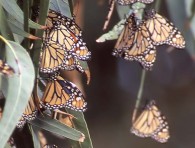
David Marriott and two colleagues (Seiko Sudo and Bill Howell) from The Monarch Program visited the Camp Pendleton monarch site to obtain wildlife permits on October 13th, 2005. While monitoring the population, Marriott tagged ONE male monarch for demonstration.
Nearly two months later, on December 8th, 2005, Marriott and a group of volunteers spotted the butterfly in a cluster of monarchs in Carpinteria at a site known as Carpinteria Creek (Santa Barbara County), about 145 miles straight line distance northwest of Camp Pendleton. One tagged monarch, one recovery — this has never happened before. The datum continues to support Marriott’s research that monarchs fly northwest to sites that have cooler microclimates when the temperatures are too warm in the Southwest (click here for migration patterns and previous records).
Butterflies subject of interpretive hike
The Monarch Program in Encinitas will be the destination of this year’s final summer interpretive hike offered by the San Marcos Community Services Department, from 11 a.m. to 1 p.m. Saturday.
Although most of the Discover San Marcos hikes take place in and around the local hills and lakes on the first Saturday of each month, the upcoming event will be more of an interpretive talk than a hike, said Susan La Joie of the community services department.
“Others [hikes] are much more aerobic-like,” she said, adding that the heat and the Labor Day weekend have combined to make the butterfly program an idea destination.
2005 Painted Lady Migration
Summerlike weather fostered a prolific hatch of desert butterflies yesterday, with gusting Santa Ana winds turning local skies into paisley landscapes. The swarms of painted lady butterflies – numbering in the millions – were a source of wonder and distraction for morning commuters, especially along the San Diego County coastline.
Albinic Monarch in Southern California
On May 7, 2005 a pale female monarch emerged at The Monarch Program Facility in Encinitas, California. Its origin was from native livestock obtained from Donna Grubusic of Caperpinteria, California (near Santa Barbara). She collected eggs and larvae from her backyard to help supply teachers and other educational programs at the Facility.
Although the monarch was not entirely white, it had a pale color that has never been recorded in the Southwest. Monarch Program records only include one very pale female monarch from Camp Pendleton in 1989, and one overwintering white monarch photographed by Lepidoperist John Lane in Santa Cruz, California in the mid-1980’s.
Freak Monarch Caterpillars
On July 22, 2004, I noticed a monarch larva from our rearing stock that looked very different. It had eight skin filaments. Within a week I noticed two more larvae with eight filaments. The extra filaments did not appear until the early third instar. I have reared many queen butterflies (Danaus gilippus) which have six filaments. But, after 15 years of rearing tens of thousands of monarchs, I have never seen more than four filaments on the larvae. I have encountered many different aberrations, but never an “eight hair” monarch larva. Some milkweed butterfly species in Africa with multi-skin filaments are common, but not in North America.
Summary: Wild Fires 2003 in Southern California
We will never know the true story of the influence of the Southern California wild fires on migrating monarchs in late October. We have evidence of survivors living through the days of dark, smoky skies (based on tagging reports), but we do not know how many perished when flying with the Santa Ana winds during the worst fire storms in the history of California.
In late November and early December, Monarch Program associates Bill Howell and David Marriott visited 59 coastal overwintering sites south of Santa Barbara County into Baja California, Mexico and toured 200 miles of fire devastated areas in San Diego County. Early reports from Howell and Marriott reflect sad news from San Diego. In some areas, or as far as the eye could see, there was nothing but the remnants of a nuclear bombing. Scattered throughout the mountains and valleys were small pockets of native vegetation that were not burned. Each of these areas may become an oasis for animals to help repopulate. Some animal species, including the Thorne’s hairstreak butterfly (Mitoura thornei), may now be extinct. It will take years to assess what type of impact the fires had on plant and animal colonies.
Painted Lady Migration Anticipated in the Southwest
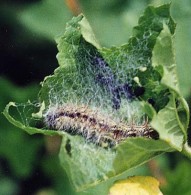
Large migrating numbers of painted lady butterflies (Vanessa cardui) and west coast lady butterflies (Vanessa annabela) should be present in the Southwest in late March and early April. Above normal rainfall in this region during the month of February helped produce an enormous wild growth of cheeseweed (Malva parviflora), a favorite host plant for these two species of painted lady butterflies.
The anticipated population increase and possible mass migration is based on a high number of larvae present on the host plants at this writing (10 March 2003). Predation is low this time of year because the caterpillar’s main predators; the tachinid flies (which parasitize the larvae), and chalcid wasps (parasitizing the pupae), are fewer in numbers this early in the season. The low number of predators should help increase the butterfly population.
Youth Projects and Opportunities, Monarch Migration Project West
The Monarch Migration Project West has great opportunities for teen groups to become part of a regional YMCA Earth Service Corp project to help the monarch butterfly. We are looking for groups to come up with a project and submit their ideas to us so we can provide funding for appropriate service projects (up to $1000 per group). We are extending this opportunity to youth environmental or school groups in the western range of the monarch butterfly and hope you will take full advantage of the support and resources we can provide. Projects can range from restoring milkweed into it’s natural range, developing an educational program, or participating in a pre-established monarch monitoring program.
Monarch Butterfly Population Appears to Be Recovering from Last Winter’s Devastating Die-Off
Illegal logging continues to be an increasing threat to butterflies. Researchers have found that North America’s monarch butterflies have at least partially recovered from last year’s devastating mass die-off in their overwintering sites, which killed approximately 80 percent of the wintering population in Mexico.
Tens of millions of the butterflies were killed as the result of an unusually cold and wet storm in January 2002. For years, scientists have argued that monarchs are more vulnerable to severe weather if the forest canopy in the sanctuaries is thinned, leaving them exposed to the elements.
Southern California in June
Visit butterflies Anise swallowtail, mourning cloak, and California dogface are just a of the native species that have taken up residency at the Butterfly Vivarium. Discovering the intricacies of gardening for butterflies, charting migration patterns, petting caterpillars, and observing the initiates emerging from their pupae are all part of the Monarch Program’s docent-led tours. Stepping inside the butterfly house, guests are encouraged to feed watermelon to the more than 80 butterflies fluttering about. Wear white: butterflies are attracted to it because it reflects heat.
Why So Few Monarchs in California This Season?
The extremely low overwintering monarch populations along the coast of California during the 2002/03 season have been declared the lowest since at least the 1960’s, especially south of Point Conception. The main culprit for this phenomenon is the five year drought in the Southwest and into central California. The lack of precipitation in the late summer of 2002 had a great impact on milkweed species in the Southwest, especially the three most common: Asclepias fascicularis (narrow leaf milkweed), A. eriocarpa (Indian milkweed), and A. subverticillata (poison milkweed). These plants have been fairly healthy in the spring months when there is some precipitation. However, during the past several years, the plants have been so stressed from lack of water in August and September that they often cannot provide a proper diet for monarch larvae.

